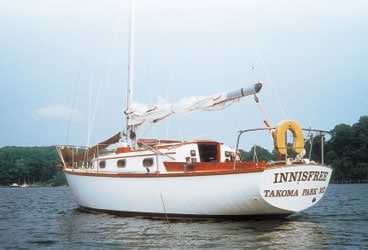
Cape Dory 28 368
I’m a longtime sailor on OPB-other people’s boats-and one crisp, Chesapeake fall day, I found myself ashore and in the process of succumbing to a quiet desperation. I did the only thing that one can do under such circumstances: I went and looked at boats.
I wandered around boatyards until I found myself gazing at a Carl Alberg-designed Cape Dory 28. Three weeks later, and despite the fact that I really hadn’t intended for it to happen, I was a boat owner.
What drew me to the Cape Dory were lines altogether typical of Alberg, including a graceful sheer that sweeps forward from a counter stern to a teak bowsprit. Teak grabrails and eyebrows accentuate the fine proportions of the long trunk cabin, and easily navigable side decks connect the generous cockpit to the fair-sized foredeck. A full keel and a keel-hung rudder complete the profile.
Details below complement the traditional exterior. Solid teak and teak veneer are abundant, and bronze, in the through-hulls and the eight opening ports, is everywhere it should be.
Above the saloon settees, narrow shelves hold books; beneath each settee lies a 30-gallon water tank. More storage spaces are located behind the seatbacks. The starboard settee serves as a single berth; the other slides out to create a slender “double.” A teak table swings down from the bulkhead and unfolds between the settees. The saloon has about 6 feet of headroom, and two opening hatches overhead help keep the air moving through it.
The head is forward of the saloon and contains a hanging wet locker and a small sink, which unfortunately drains into a fiberglass trough, then into the bilge. The marine toilet is installed below the waterline, so all valves must be closed when it’s not in use. A folding door separates the head from the V-berth, which covers various compartments. A cushioned plywood insert fills the V to create a double berth, forward of which a panel opens to the anchor locker.
The companionway, its top step on the countertop next to the single stainless-steel sink, bisects the galley, between a spacious icebox to starboard and an alcohol stove to port.
Removing the companionway stairs buys just enough room for a small person to ease over the top of the engine to service the raw-water pump or to top off the transmission oil.
Under sail, my CD 28, Innisfree, was a sound, safe, and comfortable cruising boat. She was stiff, surprisingly quick in light wind, extremely capable in heavy air, and a sheer joy off the wind. Innisfree balanced well, tracked perfectly, and, with all of her momentum, just plowed right through the Chesapeake chop. The club-footed jib, though handy for windward work when I was singlehanding, was difficult to trim properly, so I eventually installed a ProFurl furling system.
Between 1974 and 1987, Cape Dory Yachts built 388 CD 28s in East Taunton, Massachusetts. Today the 28 is listed at prices from $14,500 to $35,000. The Cape Dory Sailboat Owners Association (www.capedory.org) is just one of several groups that offers support to CD fans.
Specs
LOA 28′ 2″ (8.59 m.)
LWL 22′ 3″ (6.78 m.)
Beam 8′ 11″ (2.72 m.)
Draft 4′ 0″ (1.22 m.)
Sail Area (100%) 404 sq. ft. (37.5 sq. m.)
Ballast 3,500 lb. (1,588 kg.)
Displacement 9,000 lb. (4,082 kg.)
Ballast/D .39
D/L 365
SA/D 14.9
Water 60 gal. (227 l.)
Fuel 32 gal. (121 l.)
Engine Various
Designer Carl Alberg
Lauren Anthone sailed her Cape Dory 28, Innisfree, for six years.








